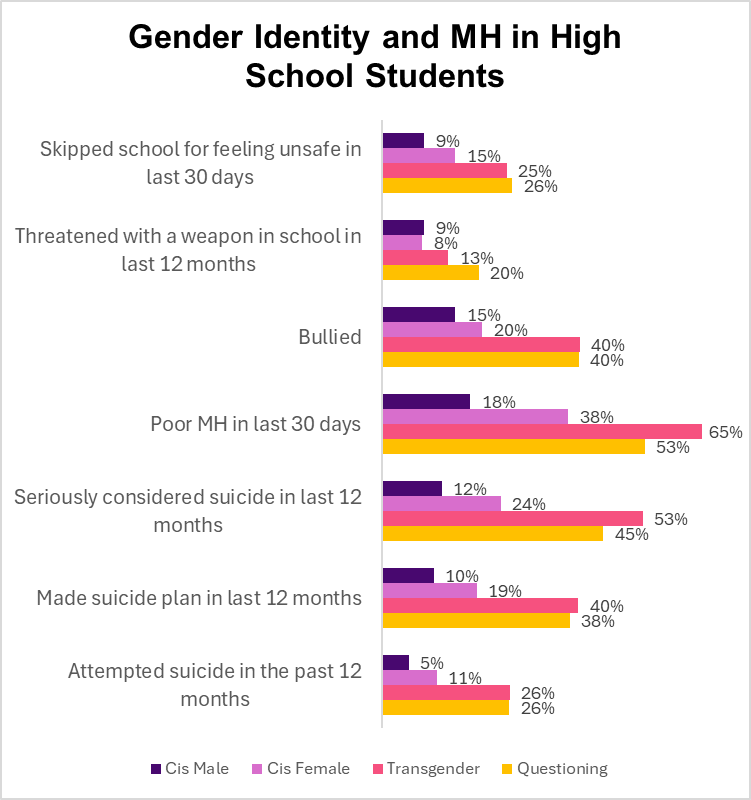Thursday Shorts: Missing cancer diagnoses, transgender, prostate cancer, and compounding
October 24, 2024
1. 130,000 Cancer diagnoses “missing” in 2020
Source Kim, et al JAMA Network Open, October 14, 2024
Researchers reviewed data on 15.8 million new cancer diagnoses from 2020-2021, and determined that about 9% fewer cancers were diagnosed during the first year of the pandemic. Cancer diagnoses returned to their previous level in 2021, but there was no “catch up,” so essentially 130,000 cases of cancer (many of them lung and prostate cancer and melanoma) were simply never diagnosed. This is one more pandemic “overhang” that could lead to worse outcomes and higher medical costs in future years.
2. Scandinavian study shows worse outcomes for watchful waiting for prostate cancer
It’s difficult to study outcomes for cancers that have a long-time course. Scandinavian researchers randomized 695 men with prostate cancer to either watchful waiting or radical prostatectomy from 1989-1999, and reported on the 30-year outcomes last week in the New England Journal of Medicine. At this point, 92% of the trial participants have died. Radical prostatectomy was associated with a 48% decrease in death from prostate cancer and a 26% decrease in death from any cause. One death from prostate cancer was prevented for every six radical prostatectomies. Employers can expect that fewer men with early prostate cancer will choose watchful waiting in light of this data.
3. Three percent of high school students identify as transgender, and overall adolescent mental health is poor
Source: Suarez, et al CDC October 10, 2024
The Centers for Disease Control and Prevention reported on its 2023 Youth Risk and Behavior Survey, which surveyed over 20,000 nationally representative high school students. The survey found that 3.3% of high school students self-identified as transgender and 2.2% questioned their gender. This is the first survey cycle where this question was asked nationally, although the researchers state that these numbers are similar to findings from 18 states that included this question in 2021 surveys.
Those youth who identified as transgender or questioning were more likely than cisgender students to be bullied and were more likely to have considered or attempted suicide. This study demonstrates that transgender high school students face enormous mental health challenges, but it also demonstrates huge mental health needs for adolescents regardless of sexual identity.
Employers should expect continued increased demand for mental health services to treat adolescents, and need to offer inclusive networks to address the needs of diverse teens. Parents of troubled teens also are more likely to benefit from mental health services.
Here’s a link to a previous post that points out that gender affirming surgery is very rare in those under age 18.
4. Racial disparities in retinal imaging
Researchers in JAMA Ophthalmology report that in over 30,000 people with diabetes seen at least twice at a single eye institute, those who self-identified as Hispanic were 32% less likely than self-identified White people to have retinal imaging, which can diagnose early diabetic retinopathy. Those who self-identified as Black were 6% less likely to have imaging than White people, but this did not reach statistical significance. These findings were adjusted for area deprivation index, insurance status, and other factors that could influence rate of imaging. Diabetic retinopathy is a major cause of preventable blindness, and rates of imaging were surprisingly low (less than one in five) for all racial/ethnic groups.
Here’s a link to last week’s post on disparities in opioid use and HIV treatment and preventive care.
5. FDA will not crack down (now) on compounding pharmacies manufacturing GLP-1 medications
What a difference a week makes! The Food and Drug Administration announced on October 2 that there was no longer a shortage of tirzepatide (Mounjaro and Zepbound), which would have meant that within thirty days 503b “bulk” compounding pharmacies would be prohibited from manufacturing copies of these patented drugs.
The compounding pharmacy trade group immediately filed suit, and the FDA filed papers in court on October 10 that they were reviewing the shortage finding and would not take any regulatory action against these compounding pharmacies at this point. The FDA has not announced the resolution of the shortage of semaglutide (Ozempic and Wegovy), so compounding pharmacies can continue to manufacture copies of that drug. So, patients can continue to obtain GLP-1 medications from compounding pharmacies, at least for now.
6. More long-term impacts of redlining
I wrote last week about long-term health impacts of redlining, where neighborhoods faced economic ruin when banks refused to make loans. Decades after redlining was outlawed, residents of these communities continue to have worse health. This week, the Boston Globe had an article on location of fatal motor vehicle accidents in Boston, and found that almost all were in neighborhoods that had previously been redlined. Here’s the image:
Thanks for reading! Hope you’ll subscribe to this newsletter, and please hit the "like" button. Please also recommend to friends and colleagues - it's free. You can find previous posts at this link.
Tomorrow: Six in ten Americans impacted by suicide.





